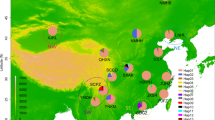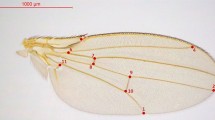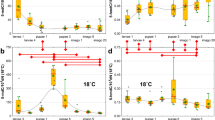Summary
Artificial directional selection for increased sternopleural chaetae number in Drosophila melanogaster is compared with a mode of directional selection which incorporates an element of disruptive selection. Compared with directional selection, this directional-disruptive selection results in a similar response but with a lower selection differential, and higher realised heritability. The differences might be attributed to a higher genetic variance maintained by the directional-disruptive selection.
Similar content being viewed by others
Article PDF
References
Barnes, B W. 1968. Stabilising selection in D. melanogaster. Heredity, 23, 433–443.
Bowman, J C, and Falconer, D S. 1960. Inbreeding depression and heterosis of litter size in mice. Genetical Research, 1, 262–274.
Enfield, F D. 1970. Effect of population structure on progress from selection in Tribolium. Journal of Animal Science, 31, 163.
Falconer, D S. 1960. An Introduction to Quantitative Genetics. Oliver and Boyd, Edinburgh.
Gibson, J B, and Thoday, J M. 1962. Effects of disruptive selection. VI. A second chromosome polymorphism. Heredity, 17, 1–26.
Gibson, J B, and Thoday, J M. 1963. Imposed quasi-random mating. Heredity, 18, 513–524.
Gibson, J B, and Thoday, J M. 1964. Effects of disruptive selection. IX. Low selection intensity. Heredity, 19, 125–130.
Goodwill, R. 1974. Comparison of three selection programs using Tribolium castaneum. Journal of Heredity, 65, 8–14.
Kearsey, M J, and Barnes, B W. 1970. Variation for metrical characters in Drosophila populations. II. Natural Selection. Heredity, 25, 11–21.
Madalena, F E, and Robertson, A. 1975. Population structure in artifical selection: studies with Drosophila melanogaster. Genet Res, 24, 113–126.
Mittler, S, and Bennet, J. 1962. A simple food medium that requires no live yeast with the minimum of variables. Dros Inf Serv, 36, 131–132.
Rathie, K A, and Nicholas, F W. 1980. Artificial selection with differing population structures. Genet Res, 36, 117–131.
Robertson, A. 1960. A theory of limits in artificial selection. Proc Roy Soc B, 153, 234–49.
Scharloo, W. 1964. The effect of disruptive and stabilising selection on the expression of a cubitus interruptus mutant in Drosophila. Genetics, 50, 553–562.
Scossiroli, R E. 1959. Selezione artificiale per un carrattere quantitative in popolazione di Drosophila melanogaster irradiate con raggi. X. Commitoto Nazionale per Recher Nucleari, Divisione Biologica (CNB-4) Roma.
Thoday, J M. 1972. Disruptive selection. Proc Roy Soc B, 182, 109–143.
Thoday, J M, and Boam, T B. 1961. Effects of disruptive selection. V. Quasi random mating. Heredity, 16, 219–223.
Thoday, J M, and Gibson, J B. 1972. A simple test for stabilising and disruptive selection. Egyptian Journal of Genetics and Cytology, 1, 47–50.
Thoday, J M, Gibson, J B, and Spickett, S G. 1964. Regular responses to selection. 2. Recombination and accelerated response. Genet Res, 5, 1–19.
Wolstenholme, D R, and Thoday, J M. 1963. Effects of disruptive selection. VII. A third chromosome polymorphism. Heredity, 18, 413–431.
Wright, S. 1935. The analysis of variance and the correlations between relatives with respect to deviations from an optimum. J Genet, 30, 243–256.
Wright, S. 1978. The relation of livestock breeding to theories of evolution. Journal of Animal Science, 46, 1192–1200.
Author information
Authors and Affiliations
Rights and permissions
About this article
Cite this article
Yousif, M., Skibinski, D. Directional-disruptive selection in Drosophila melanogaster. Heredity 49, 71–79 (1982). https://doi.org/10.1038/hdy.1982.66
Received:
Issue date:
DOI: https://doi.org/10.1038/hdy.1982.66
This article is cited by
-
Directional selection in lines founded from different parts of the phenotypic distribution of sternopleural chaetae number in Drosophila melanogaster
Theoretical and Applied Genetics (1989)
-
Quantitative genetics and fitness: lessons from Drosophila
Heredity (1987)



